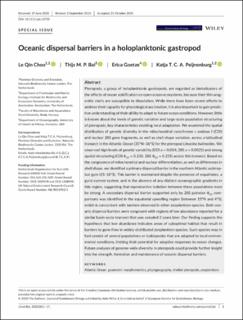| dc.contributor.author | Choo, Le Qin | |
| dc.contributor.author | Bal, Thijs M.P. | |
| dc.contributor.author | Goetze, Erica | |
| dc.contributor.author | Peijnenburg, Katja T.C.A. | |
| dc.date.accessioned | 2021-03-05T12:50:48Z | |
| dc.date.available | 2021-03-05T12:50:48Z | |
| dc.date.created | 2021-01-12T14:27:31Z | |
| dc.date.issued | 2020 | |
| dc.identifier.citation | Choo, L. Q., Bal, T. M. P., Goetze, E. & Peijnenburg, K. T. C. A. (2020). Oceanic dispersal barriers in a holoplanktonic gastropod. Journal of Evolutionary Biology, 34(1), 224-240. doi: | en_US |
| dc.identifier.issn | 1420-9101 | |
| dc.identifier.uri | https://hdl.handle.net/11250/2731891 | |
| dc.description.abstract | Pteropods, a group of holoplanktonic gastropods, are regarded as bioindicators of the effects of ocean acidification on open ocean ecosystems, because their thin aragonitic shells are susceptible to dissolution. While there have been recent efforts to address their capacity for physiological acclimation, it is also important to gain predictive understanding of their ability to adapt to future ocean conditions. However, little is known about the levels of genetic variation and large‐scale population structuring of pteropods, key characteristics enabling local adaptation. We examined the spatial distribution of genetic diversity in the mitochondrial cytochrome c oxidase I (COI) and nuclear 28S gene fragments, as well as shell shape variation, across a latitudinal transect in the Atlantic Ocean (35°N–36°S) for the pteropod Limacina bulimoides. We observed high levels of genetic variability (COI π = 0.034, 28S π = 0.0021) and strong spatial structuring (COI ΦST = 0.230, 28S ΦST = 0.255) across this transect. Based on the congruence of mitochondrial and nuclear differentiation, as well as differences in shell shape, we identified a primary dispersal barrier in the southern Atlantic subtropical gyre (15–18°S). This barrier is maintained despite the presence of expatriates, a gyral current system, and in the absence of any distinct oceanographic gradients in this region, suggesting that reproductive isolation between these populations must be strong. A secondary dispersal barrier supported only by 28S pairwise ΦST comparisons was identified in the equatorial upwelling region (between 15°N and 4°S), which is concordant with barriers observed in other zooplankton species. Both oceanic dispersal barriers were congruent with regions of low abundance reported for a similar basin‐scale transect that was sampled 2 years later. Our finding supports the hypothesis that low abundance indicates areas of suboptimal habitat that result in barriers to gene flow in widely distributed zooplankton species. Such species may in fact consist of several populations or (sub)species that are adapted to local environmental conditions, limiting their potential for adaptive responses to ocean changes. Future analyses of genome‐wide diversity in pteropods could provide further insight into the strength, formation and maintenance of oceanic dispersal barriers. | en_US |
| dc.language.iso | eng | en_US |
| dc.publisher | Wiley | en_US |
| dc.rights | Navngivelse 4.0 Internasjonal | * |
| dc.rights.uri | http://creativecommons.org/licenses/by/4.0/deed.no | * |
| dc.title | Oceanic dispersal barriers in a holoplanktonic gastropod | en_US |
| dc.type | Peer reviewed | en_US |
| dc.type | Journal article | en_US |
| dc.description.version | publishedVersion | en_US |
| dc.rights.holder | © 2020 The Author(s) | en_US |
| dc.subject.nsi | VDP::Marinbiologi: 497 | en_US |
| dc.subject.nsi | VDP::Marine biology: 497 | en_US |
| dc.source.pagenumber | 224-240 | en_US |
| dc.source.volume | 34 | en_US |
| dc.source.journal | Journal of Evolutionary Biology | en_US |
| dc.source.issue | 1 | en_US |
| dc.identifier.doi | 10.1111/jeb.13735 | |
| dc.identifier.cristin | 1869908 | |
| dc.description.localcode | Paid Open Access | en_US |

